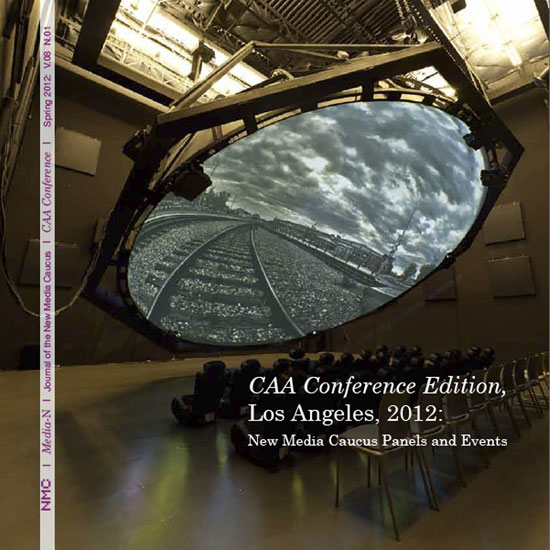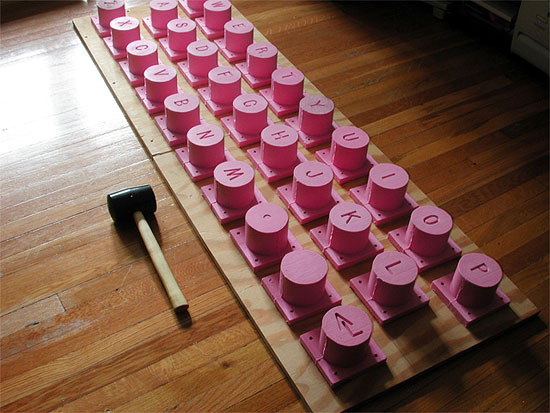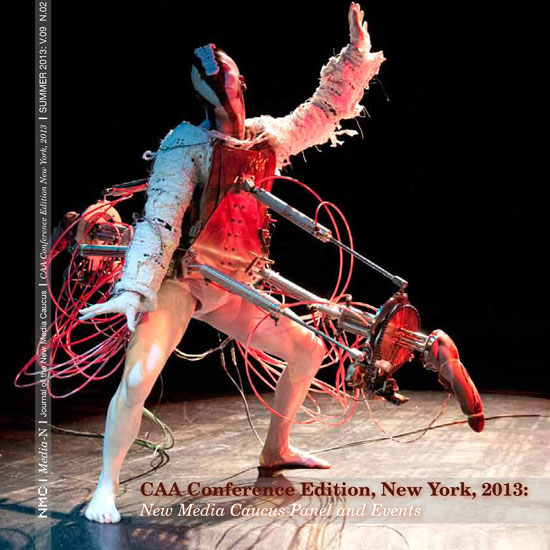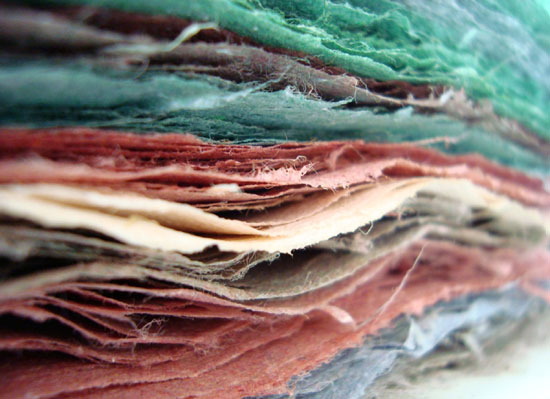Pat Badani at CAA
In Conversation with Media-N
Journal of the New Media Caucus
College Art Association Conference
Chicago – February 2014

CAA Conference Edition, Los Angeles, 2012, Media-N Journal of the NMC, cover of the summer print edition, 2012, V.08, N.01.
Excerpts From The Interview
Chicago – February 2014
Preview & Download The Entire Document Below
Joshua Selman Interviews Pat Badani, Editor in Chief, Media-N Journal
While attending the College Art Association Conference at the Chicago Hilton, February 11th to 15th, I was embedded in a special community made up of scholars in art education, art history and art criticism. The annual conference itself aims to “cultivate the ongoing understanding of art as a fundamental form of human expression.” (“About CAA.” College Art Association. 11 Nov. 2004. CAA. 25 Oct. 2010: http://www.collegeart.org/about/mission ) With over 13,000 members CAA’s influence is international in scope, and this year I engaged one of its most interesting affiliates: The New Media Caucus, a nonprofit, international membership organization that aims to advance the conceptual and artistic use of digital media ( http://median.newmediacaucus.org ). It’s been gratifying to learn just how modest the organization’s online description of its mandate is. While The New Media Caucus does advance the conceptual and artistic use of digital media, its premise has evolved with very far reaching implications. For The New Media Caucus, the internal definition of new media practice is dialectic in that the NMC is prepared to re-define its scope as new media evolves throughout time.
Pat Badani, the Editor in Chief of the Media-N, Journal of the New Media Caucus, is working with me as a correspondent at CAA. Together we have launched a discussion – from within the conference – to examine what is happening at CAA this year as it applies to the New Media Caucus, to Media-N Journal and to CAA members. I am very pleased to present this conversation with Pat Badani, who is an arts practitioner, educator, curator and editor, with an MFA from the School of the Art Institute of Chicago. Pat is on the executive board of the New Media Caucus and is an ISEA International Advisory Committee affiliate. I have joined The New Media Caucus and personally attended each of their CAA Conference presentations onsite at the Hilton in Chicago, as well as each special NMC offsite event and exhibition concurrent with the conference.
The following excerpts from my conversation with Pat Badani give a hint of what is in the full interview. Please scan through it using the viewer below and download the PDF to save and view it for a full reading.

Sledgehammer-operated Keyboard, 2005 – ongoing, Taylor Hokanson,
Human-Computer Interface, © Taylor Hokanson.
JS: Are the New Media Caucus members exclusively those teaching in college and university departments of new media and are the New Media Caucus members exclusively working with New Media Art?
PB: The membership is definitely a mix of digital media practitioners and academics. To the second part of your question, we have a constitution that defines new media as an experimental form that is always reinventing itself. We define it both in specific terms and as an open-ended idiom, because we know that new media will evolve five or ten years from now.
JS: The Media-N Journal, as it stands today, follows a familiar and very manageable presentation format in that it’s both in print and online. Everyone should make sure to download a copy, if they haven’t ordered one already, here. The experience of the print version is quite rich by comparison to the online version, which is mostly scripted html. How do you see where you are now with formatting the journal and where you might be in the future?
PB: Interestingly, this is something we discussed in a closed Media-N publication sub-committee meeting during CAA. The format we now use is WordPress online, and a print-on-demand edition designed by very talented graphic designers. Online, there is a way of extracting an Adobe pdf directly from WordPress, but we decided to work with our designers on beautiful, collectible, books. We’re perfectly aware that we have an online version that’s open access. Yet we also have a collectible, precious object, for purchase at a reasonable price. The more we talk about moving into other publication formats, we’re developing our philosophy beyond “pixel versus paper.” Why not have a series of publication formats and subjects within the Media-N Journal, with that branding? Some of them could be electronic publications that come out of our new media exhibitions; they could follow – or disrupt – the catalogue format with critical essays by artists and historians in addition to artists’ statements and the work itself. That could be one of many forms as added publication formats.

CAA Conference Edition, New York, 2013, Media-N Journal of the NMC,
cover of the print summer edition, 2013 edition, V.09, N.02.
We are also looking into publishing through SCALAR, an open source platform created by a team at USC that allows for media rich investigations and publications. It supports a type of journal where users can chart non-linear paths through multi-modal, modular, Web-born content and media. We might also develop a publication that does not necessarily follow the strict academic format, which is what we have right now. It has to be said that we’ve been working for several years in order to perfect our current format. Why? Because it serves our constituency, made of large numbers of academics that can use our publication as a way to obtain tenure and promotion. The essays we currently publish meet the strict academic specifications for tenure and promotion packages. Beyond that, researchers, educators, students and artists use our publication as a reliable resource. So, we do serve a purpose by publishing a traditional academic journal. However, there are many other interesting directions for us to include. It’s not a matter of dropping what we’re doing, because it does serve a purpose, but rather, adding other forms of publications that allow various types of voices and representations.
JS: How do you see the strategic partnership between Artist Organized Art, the New Media Caucus and the Media-N Journal? What do you see on the horizon that could evolve through the two organizations, which have very different missions?
PB: It’s interesting to give new media an outward facing stance. With new media, as with photography in its day, with video in its day, and with performance, in the initial decade in which emerging practices and technologies are being experimented with, the artist faces a number of problems.
Number one: Access to the technology. This creates camaraderie between like-minded individuals who share technology, discuss and improve upon it. “I want to learn from you. Or, I want to borrow your device,” etc.
Number two: Our art practice imposes difficulty with showing and disseminating our work due to lack of technology support. In addition, there’s lack of interest on the part of institutions, and lack of a viewing or participating public. Contemporary art curators often lack interest because of a lack of familiarity with our language and with the technology. So they often opt out of showing us, or including electronically controlled art work in survey exhibitions. Ultimately, bodies such as journals, magazines and books, won’t touch us because they’re missing our reading public. So, new media artists are kept out of the “cultural market,” let alone the commercial market. The cultural market makes it possible to be seen – understood – mediated. Thus, the isolation of new media gives rise to particular platforms such as festivals, symposia and specialized publications. Things become grounded and formalized, typically in the second to third decade of practice, when the practitioners themselves have developed theory, developed programs within universities and designed courses of study, and validation platforms like exhibition and publication environments. There is a point when the “new” media joins mainstream art. The initial problems are eliminated for the most part; the language being used by these artists becomes part of the mainstream. Then, predictably, a newer media emerges, a newer technology, or a newer practice and a newer community of inquiry seeks its proper enclave.
This has been happening with electronic technologies for a number of years. I think now we can safely say we’re gradually becoming part of the mainstream, in that the mainstream is actually talking about us in both negative and positive terms, but while we’re being considered by critics, by curators, by directors, there is ambivalence.
I go to a lot of festivals, a lot of symposia where there is a conversation being held right now by individuals who are in significant editorial and curatorial positions of new electronic art, writing books and curating exhibitions, who are less practitioners, but work more in a theoretical realm. What I hear them saying is that the divide between media art histories and art history needs to be addressed. How do those two realms come together? I think we are at that moment in history where we will increasingly see a co-mingling, a cross-referencing of the art theories and histories. Artists are already doing it, and in my view, critical theory has to support practice.

Stack of Open Source Paper, 2009, Denise Bookwalter, Anna Child, Laurie Corral,
Brooks Edwards, Cutler Edwards, Lyman Edwards, Bridget Elmer, Stacy Elmer,
Andy Grace, Rashmi Grace, Mark Greeley, Emily Larned,
Sam Nichols, Jessica Peterson and Emily Tipps,
handmade paper, Copyleft Flatbed Splendor.
JS: Would you agree that a minimum benefit of submitting a paper for consideration, even if it’s not selected, is to receive valuable feedback, pertinent to the submission?
PB: Yes, very much so. We’ve been thanked over and over again for doing that; especially by certain authors who may need experience with publishing. One of Media-N Journal’s missions is to mentor young scholars. One method as Editor-in-Chief is to ask an associate editor to act as supporting editor for the guest editors. We consult on editing submitted essays, so that development is coherent and top quality. Scholars, particularly younger scholars, are usually delighted to work with us in this way, because of the learning process and the camaraderie that we establish in the process.
JS: You’ve described a balance of separate and mutually supporting selection processes between the CAA Conference presentations, the off-site presentations and the three editorial programs of Media-N. As the off-site presentations beyond the CAA Conference grow, what impact will they have on the Media-N Journal?
PB: That’s an area for experimentation, which we like to do. We’ve been talking about doing something very specific, centered on the New Media Caucus, with a regional location for exhibitions, or other related ways to share. For example, we could hold a workshop to share experience with emerging technologies; work with artists, scholars, organizations, directors and curators to measure the potential support for events at their regional institution. Chicago, for example, has a high density of New Media Caucus members. Regions, such as this one, might also call people from Wisconsin, Indiana and other adjoining States. The regional off-site events would be branded as the New Media Caucus, but they might generate their own formats…these ideas are still in the process of elaboration, and it is all very exciting to us! It’s in discussion.
JS: How did working with the multi-institutional hosts CAA, Columbia College and the Chicago Cultural Center benefit the New Media Caucus and Media-N during the CAA 2014 Conference and what role will multi-institutional support take in the future?
PB: It’s exciting to be hosted whether we are joining CAA in New York City, or CAA in Los Angeles, but we also partner with offsite institutions. Sometimes we team up with learning institutions such as Columbia College in Chicago. In Los Angeles we’ve worked with three digital media centers that host our events. It’s important that we present within the CAA context, which is usually in a conference setting in a hotel, but also to present offsite events and round tables. It’s how we round out our substantial program. We are only allowed two panels at CAA itself. That is a CAA rule and as a Caucus we must abide by this limit.
So the benefit, of course, is that it helps the New Media Caucus broaden its reach. It helps us present events and exhibitions that we wouldn’t be able to show at CAA, because we’re limited to two panels. Hosts benefit the New Media Caucus and we also benefit institutional hosts, because we are bringing very unusual material that draws quite a crowd from the community at large and our events are well attended by a community which benefits the hosting institution.
JS: What role can an organization like Artist Organized Art take to help remove the divide between media art histories and art history?
PB: What interests me about Artist Organized Art – the organization itself – is what its title refers to. The New Media Caucus is precisely that. We, as a group of artists, have organized ourselves into a Caucus in order to create a forum for the presentation and distribution of our voices, of our community, of our output as artists, and – for those who are academics – our output as academics as well. What interests me is the notion of artists organizing their position in culture without any supporting structure, without funding, as volunteers. We do this because somebody must. If Artist Organized Art has a similar mandate, and it also reaches a wider community, the affiliation or partnership is of mutual interest, because it allows us to interface contrasting, but aligned, communities.
JS: We focus on many different aspects of a critical jumping off point. How does an artist choose to engage the world. We inquire whether artists choose to address the question. It seems natural to members of the New Media Caucus to question parameters of engagement, but to those working on an MFA in a categorized art form, or for artists working in performance, preparing for a white box or stage is generally accepted right out of the gate. We prepare work around installing in a white box and accept this, letting specialists put out interpretations of our work, instead of conveying our own intentions as part of the work itself. Artist Organized Art supports including many parameters of engagement within the compositional paradigm around structured conditions of art-making. These conditions are conventionally alienated from art practitioners, who are constrained specifically because they don’t include these parameters, and it does effect their ability to develop works. This may not be obvious to New Media artists, because of, on the other hand, the difficulties of finally managing so many parameters.
PB: Actually, we are aware of that, because (..more)
Download The Entire Interview (Right click and “save link as” for direct download)
Pat Badani
is an arts practitioner, educator, curator and editor, with an MFA from the School of the Art Institute of Chicago. Concerned with the relationship between art and social practice, over the last 30 years Badani has exhibited her work, participated in conferences and panels, and published widely in North and South America, Europe and Asia. She has received over twenty awards and commissions - notably a one-year Canada Council Media Arts research grant in 2001 for her transnational project "Where are you from? Stories dealing with human migration, and a 2012 "Robert Heinecken Trust Fund" for her project “AI Grano" focusing on biodiversity issues related to maize agriculture. Badani has lived in 7 countries in the Americas and Europe and has held academic positions in Canada, France and in the USA. Recent curatorial projects include a partnership with Lanfranco Aceti in a series of panels and an exhibition on the rhetoric and realities of artistic interventions in public space, from performance to Augmented Reality art. Badani is currently Editor-in-Chief of
Media-N Journal, executive board officer with the New Media Caucus, and an ISEA International Advisory Committee affiliate.
Media-N was established in 2005 to provide a forum for New Media Caucus members and non-members alike, featuring their scholarly research, artworks and projects. The New Media Caucus is a nonprofit, international membership organization that advances the conceptual and artistic use of digital media. Additionally, the NMC is a College Art Association Affiliate Society. http://median.newmediacaucus.org/
The College Art Association of America
(CAA) is the principal professional association in the United States for practitioners and scholars of art, art history, and art criticism. Founded in 1911, it aims to "cultivate the ongoing understanding of art as a fundamental form of human expression." CAA currently has 13,000 members, primarily academics, professors, and graduate students in art practice, history, or theory, including visual arts, visual culture, and aesthetics. Its membership, concerns, reputation, and influence are international in scope.
Artist Organized Art
non-profit works with artists & institutions to support artist organized media, events & cultural education by strategic, collaborative & financial means. As a 501(c)(3) tax-exempt organization it provides strategic support to artists and organizations working in & benefiting communities everywhere in the world. Its current following has an all time high of over 150,000 subscribers. Email announcements reach 75,000+ global arts professionals & their followers: 44% North America, 33% Europe, 23% Asia and beyond. Artist Organized Art is advised by, followed by & supported by some of the most prestigious independent artists, organizers, curators, historians and institutions in the world, including founding members of Fluxus, members of the International Artists Museum and the publishers of New Observations Magazine. http://www.artistorganizedart.org
Joshua Selman
is an artist, composer and graduate of Yale University with a Master of Music Composition whose intermedia practice combines public space intervention, large-scale installation, cultural-strategy and critical journalism. His sound work is included on Westdeutscher Rundfunk, Cologne, Germany. He's also known for performance works and objects with unique virality. Some were included in a Whitney Museum Ray Johnson retrospective. Other collaborations are with Fluxus founders Alison Knowles and late intermedia theorist Dick Higgins. He first exhibited as An intermedia artist at New York Fluxus venue, the Emily Harvey Gallery. His participation in several artist organized Biennials known as Construction in Process led to a post as Executive Director of The International Artists Museum, New York Center. He's also documented as a commercial innovator in social networks, by Wired Online in 2004, and referenced in a Facebook patent. In 2003, he launched the online space Artist Organized Art. In 2007, as President, he established Artist Organized Art, a new media based arts organization, as a tax-exempt 501(c)3. In late 2008 he guided Artist Organized Art to acquire New Observations LTD, publisher of
New Observations Magazine, with a mandate to relaunch the seminal arts publication. He has gained long term support for the organization from Google Inc. His networked activities now include thousands of artists in the Americas, Europe, Asia and beyond. Residencies include South Korea, Germany, Australia, Canada, the USA and China. His works in Performa, on the High Line, other appearances and interviews are documented in print, on the we band on television.